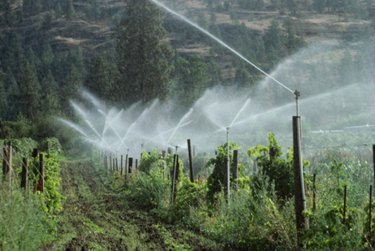Things You'll Need
Sprinkler manifold
Gloves
Flat-head screwdriver

Almost all irrigation systems, for commercial or residential applications, contain a built-in drain valve. This valve is typically located on the sprinkler manifold, which controls the flow of water to individual zones. This drain valve allows users to literally pull the plug on the system, and for the water to drain from the manifold and the vacuum breaker. These two parts are the most susceptible to breakage, so it's important to drain them at the end of every watering season.
Manual Draining
Step 1
Locate the sprinkler manifold. It is usually located inside an irrigation control box, which is black with a green lid. Look for it around the perimeter of the house or business.
Video of the Day
Step 2
Open the lid. You may have to insert a flat-head screwdriver into the tab on the top to pry the lid open.
Step 3
Locate the drain valve. It is usually red, and located at the end of the manifold assembly.
Step 4
Pull up all of your sprinkler heads if they contain check valves. This will allow the water to flow back to the manifold. Sprinkler heads can be pulled using your fingers or a pair of needle-nose pliers.
Step 5
Put on protective gloves. Turn the drain valve counterclockwise until it stops. Water will begin rushing from the valve opening.
Step 6
Allow the system to drain itself for at least five minutes.
Step 7
Unscrew the drain cap on the bottom of the vacuum breaker, and turn both handles on the breaker to 45-degree angles. This will allow any remaining water inside the breaker or the supply line to drain out.
Step 8
Leave the valve open for the winter. This will allow any remaining water to expand and leave the system without breaking the manifold.
Video of the Day